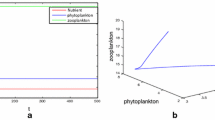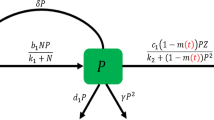Abstract
We consider a closed Nutrient-Phytoplankton-Zooplankton (NPZ) model that allows for a delay in the nutrient recycling. A delay-dependent conservation law allows us to quantify the total biomass in the system. With this, we can investigate how a planktonic ecosystem is affected by the quantity of biomass it contains and by the properties of the delay distribution. The quantity of biomass and the length of the delay play a significant role in determining the existence of equilibrium solutions, since a sufficiently small amount of biomass or a long enough delay can lead to the extinction of a species. Furthermore, the quantity of biomass and length of delay are important since a small change in either can change the stability of an equilibrium solution. We explore these effects for a variety of delay distributions using both analytical and numerical techniques, and verify these results with simulations.


















Similar content being viewed by others
Notes
In the case where the delay distribution extends infinitely into the past, the delay distribution must be approximated by a truncated version for simulation purposes.
References
Armstrong RA (1994) Grazing limitation and nutrient limitation in marine ecosystems: steady state solutions of an ecosystem model with multiple food chains. Limnol Oceanogr 39(3):597–608
Armstrong RA (1999) Stable model structures for representing biogeochemical diversity and size spectra in plankton communities. J Plankton Res 21(3):445–464
Beretta E, Bischi GI, Solimano F (1990) Stability in chemostat equations with delayed nutrient recycling. J Math Biol 28:99–111
Caswell H, Neubert MG (1998) Chaos and closure terms in plankton food chain models. J Plankton Res 20(9):1837–1845
Churchill RV, Brown JW (1984) Complex Variables and Applications. McGraw-Hill, New York
Diekmann O, Gyllenberg M (2012) Equations with infinite delay: Blending the abstract and the concrete. J Differ Equ 252:819–851
van den Driessche P, Zeeman ML (1998) Three-dimensional competitive Lotka-Volterra systems with no periodic orbits. SIAM J Appl Math 58(1):227–234
Edwards AM (2001) Adding detritus to a nutrient-phytoplankton-zooplankton model: a dynamical-systems approach. J Plankton Res 23(4):389–413
Franks PJS (2002) NPZ models of plankton dynamics: their construction, coupling to physics, and application. J Oceanogr 58:379–387
Franks PJS, Wroblewski JS, Flierl GR (1986) Behavior of a simple plankton model with food-level acclimation by herbivores. Mar Biol 91:121–129
Gentleman W, Leising A, Frost B, Strom S, Murray J (2003) Functional responses for zooplankton feeding on multiple resources: a review of assumptions and biological dynamics. Deep-Sea Res II 50:2847–2875
Gentleman WC, Neuheimer AB (2008) Functional responses and ecosystem dynamics: how clearance rates explain the influence of satiation, food-limitation and acclimation. J Plankton Res 30(11):1215–1231
Govaerts WJF (2000) Numerical methods for bifurcations of dynamical equilibria. SIAM, Philadelphia
Hale JK, Somolinos AS (1983) Competition for fluctuating nutrient. J Math Biol 18:255–280
He XZ, Ruan S (1998) Global stability in chemostat-type models with delayed nutrient recycling. J Math Biol 37:253–271
Hino Y, Murakami S, Naito T (1991) Functional Differential Equations with Infinite Delay. Springer-Verlag, Berlin
Holling CS (1966) The functional response of invertebrate predators to prey density. Mem Entomol Soc Can 48:1–86
Jang SRJ, Baglama J (2005) Nutrient-plankton models with nutrient recycling. Comp Math Appl 49:375–387
Kmet T (1996) Material recycling in a closed aquatic ecosystem. II. Bifurcation analysis of a simple food-chain model. Bull Math Biol 58(5):983–1000
Kolmanovskii V, Myshkis A (1999) Introduction to the Theory and Applications of Functional Differential Equations. Kluwer Academic Publishers, Dordrecht
Levin BR, Stewart FM, Chao L (1977) Resource-limited growth, competition, and predation: a model and experimental studies with bacteria and bacteriophage. Am Nat 111(977):3–24
May RM (1973) Time-delay versus stability in population models with two and three trophic levels. Ecology 54(2):315–325
Murray JD (1989) Mathematical biology. Springer-Verlag, Berlin
Poulin FJ, Franks PJS (2010) Size-structured planktonic ecosystems: constraints, controls and assembly instructions. J Plankton Res 32(8):1121–1130
Ruan S (1998) Turing instability and travelling waves in diffusive plankton models with delayed nutrient recycling. IMA J Appl Math 61:15–32
Ruan S (2001) Oscillatons in plankton models with nutrient recycling. J Theor Biol 208:15–26
Ruan S, Xiao D (2001) Global analysis in a predator-prey system with nonmonotonic functional response. SIAM J Appl Math 61(4):1445–1472
Ulanowicz RE (1972) Mass and energy flow in closed ecosystems. J Theor Biol 34:239–253
Wroblewski JS, Sarmiento JL, Flierl GR (1988) An ocean basin scale model of plankton dynamics in the North Atlantic 1. solutions for the climatological oceanographic conditions in May. Glob Biogeochem Cycles 2:199–218
Zhu H, Campbell SA, Wolkowicz GSK (2002) Bifurcation analysis of a predator-prey system with nonmonotonic functional response. SIAM J Appl Math 63(2):636–682
Acknowledgments
The authors gratefully acknowledge financial support from the Natural Sciences and Engineering Research Council of Canada. M.K. also gratefully acknowledges financial support from the Ontario Graduate Scholarship Program.
Author information
Authors and Affiliations
Corresponding author
Rights and permissions
About this article
Cite this article
Kloosterman, M., Campbell, S.A. & Poulin, F.J. A closed NPZ model with delayed nutrient recycling. J. Math. Biol. 68, 815–850 (2014). https://doi.org/10.1007/s00285-013-0646-x
Received:
Revised:
Published:
Issue Date:
DOI: https://doi.org/10.1007/s00285-013-0646-x




